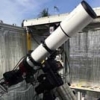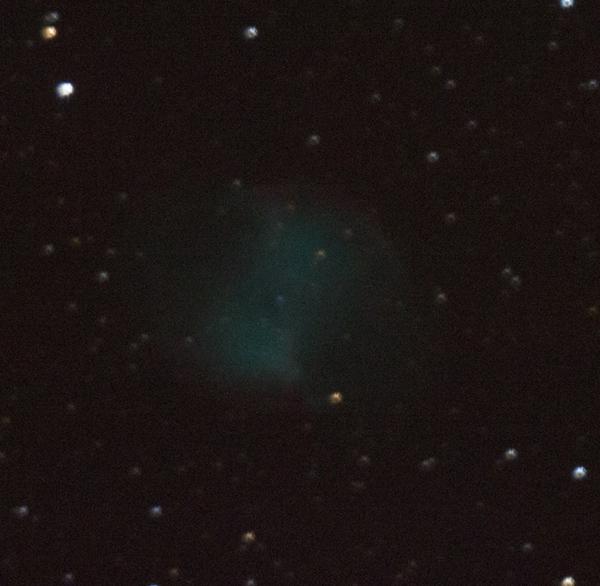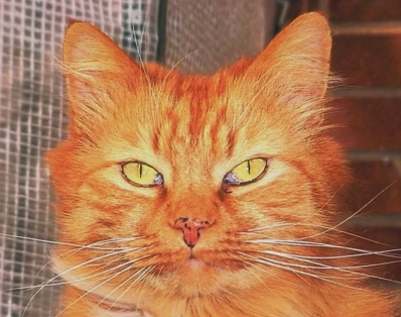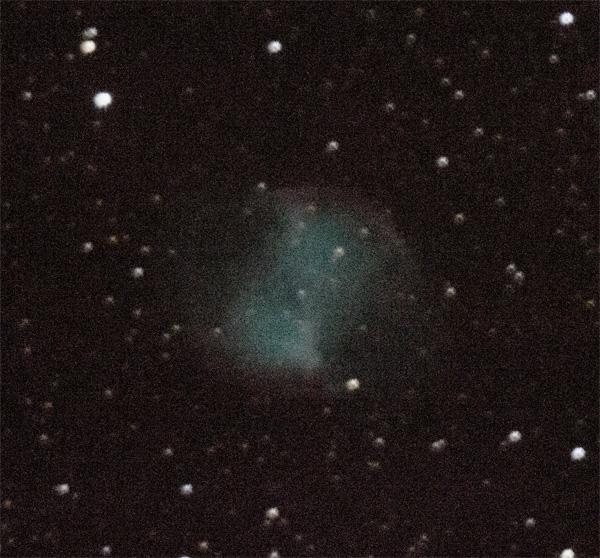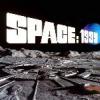
AP Images Taken with Original NexStar
#201

Posted 18 December 2011 - 10:55 AM
thanks
Andy
#202

Posted 18 December 2011 - 10:58 AM
thanks
Andy
#203

Posted 18 December 2011 - 11:07 AM
Yep, 6.3 is the one to get.
-Dan
#204

Posted 18 December 2011 - 11:51 AM
Below is a single image of the Dumb-bell from last night. I see it has color, but when I stack images in Deep Sky Stacker, I lose the color. Seems to only work in Grey Scale.
#205

Posted 18 December 2011 - 12:58 PM
Any focal reducer serves to reduce the focal length of any telescope by a nominal amount which in turn, leads to a reduction in magnification for any given eyepiece and consequently, an increase in its angular field of view.
In practical terms therefore, your 8SE has a focal length of 2000mm. However, add the Celestron f/6.3 focal reducer and the focal length is reduced to 1260mm or 63% of the original 2000mm value.
Now consider the effect on magnification.
Say, for example, you place the standard supplied 25mm eyepice in your 'scope without any focal reducer, then the magnification obtained from it will result from the focal length of your 8SE, (2000mm), divided by that of the eyepiece, (25mm), to therefore produce a magnification of 2000/25 = X80.
Now if you were to use the Celestron focal reducer which will reduce the focal length of your 8SE to 1260mm, then using the same 25mm eyepiece, the magnification produced this time, would be 1260/25 = X50.4.
With the lowering of the magnification comes a proportional increase in the field of view: i.e. that what you can see through the eyepiece expands as magnification diminishes, (within other constrains imposed by the optics and mechanics of the 'scope design itself).
Finally you'll probably note that some reducers like the Celestron f/6.3 is also claimed to be a "Field Flattener". This means that it has the additional ability to lessen the optical distortion of stars at the outer edge of the field of view; an unwanted but inherent phenomenon associated with Schmidt-Cassegrain 'scopes.
I have related these examples purely to visual use and thus eyepieces but the same is true for any camera you attach to your 'scope be it a DSLR, CCD or webcam.
Should you require a more in depth explanation of field of view calculation, I'm happy to provide.
Hoping this may explain a little,
Best regards,
Tel
#206

Posted 18 December 2011 - 01:10 PM
Tel gave a great explanation of the function. Just want to point out that there can be some confusion on the part of a newbie regarding the terminology.
Some people call it a 6.3 focal reducer. That's because it makes an f/10 scope into a scope which is effectively f/6.3. Others call it a 0.63 or 0.63x focal reducer. That's because it changes your magnification by 0.63x. It's the opposite of a barlow which increases your magnification by 2x, or 3x, or whatever the rating is. Reducing your magnification will increase your field of view - how much of the sky you can see - so you can see larger objects.
Aside from the number, some call it a focal reducer, some call it a field flattener, and some use abbreviations like fr, ff, fr/ff. It's all the same thing. When you're talking about a standard 6.3 focal reducer designed for an f/10 SCT, it is both a focal reducer and field flattener. There are some other styles made for other types of scopes, which are sometimes just one or the other.
-Dan
#207

Posted 18 December 2011 - 01:12 PM
To help you further and particularly with your imaging, take a look perhaps at Rod Wodaski's "New Astronomy Press CCD Calculator".
http://www.newastro..../camera_app.php
This free downloadable calculator is not, as the title suggests, specific to CCD cameras: it's also applicable to DSLRs and should provide you with a good insight into the effects of focal length variations, the addition of focal reducers, types of camera and resulting fields of view.
I hope this helps a little more.
Best regards,
Tel
#208

Posted 18 December 2011 - 01:47 PM
I think I have to list my priorities, and I think it is going to start with the equatorial mount first. This reducer is more of a stocking stuffer, but I need to get the mount...
Pretty clear from my time out at the dark sky site here last night that this is all pretty feasible. I actually can get to many of the objects in my light polluted backyard.
One other question, do you understand why Deep Sky Stacker forces me into grey scale? Their documentation is pretty limited.
#209

Posted 18 December 2011 - 02:35 PM
Best regards,
Tel
#210

Posted 18 December 2011 - 02:53 PM
I assume the files you posted were jpg. Do you have Photoshop? Or PS elements? If so, you can save the images out of Registax as TIFF (16 bit RGB), bring them into PS. By making adjustments in levels and curves you can probably improve your images, especially where there is data hiding (M31) or where the core of M42 is blown out. Then when you are satisfied, save them as jpg for posting here and elsewhere.
BTW, that M1 is excellent!
#211

Posted 18 December 2011 - 02:55 PM
ANOTHER great Jupiter image! The GRS literally jumps out at you! Very nice!
#212

Posted 18 December 2011 - 04:44 PM
Regarding the discussion about focal reducers, when it comes to using them on our f/10 SCT's, is their primary function to make a wider field or do they truly make the scope perform like an f6.3 instrument? I ask because if it was operating at 6.3, obviously faster than f/10, would it not cut down on exposure times? For instance, would it shorten frame integration times on the mallincam, or would it still be slower since it isn't converted until it almost hits the "eyepiece". Would it be correct to say that the addition of an FR would give the widefield performance of an f/6.3 instrument, but it would still be hindered on speed of exposure by it's native f/10 config?
Sorry for the questions, still new to me.
Andy
#213

Posted 18 December 2011 - 07:52 PM
The f ratio is a factor that can cause a lot of confusion when applied to telescopes. You'll hear things like "an f/4 scope requires shorter exposures than an f/10 scope". While that CAN be true under certain circumstances, it may not be in others.
The problem is that f ratio is commonly used by photographers when comparing lenses. However, they are ALWAYS comparing lenses of the same focal length. So, a 200mm telephoto that is f/4 will be "faster" and require shorter exposures than a 200mm f/8 telephoto. However, a photographer would never compare the f ratio of a 28mm wide angle lens to a 200mm telephoto. It just doesn't make any sense.
An f ratio is indeed a ratio. It is the ratio of focal length to aperture diameter. So you can change the f ratio by changing either one. The ONLY one that will affect the length of the exposure FOR THE SAME SIZE IMAGE (<- important!) is the aperture. A larger aperture lets in more light and will allow shorter exposures.
Let's compare two scopes:
Focal length 800mm, aperture 100mm, focal ratio = f/8
Focal length 400mm, aperture 100mm, focal ratio = f/4
Note that, if you take a photo with each of these with the SAME image scale, they will both require the SAME exposure because they have the same aperture. The 400mm scope will have half the magnification of the 800mm, so it will require a 2x barlow to get the same image scale. This, of course, reduces the brightness so you're back to the same exact light level as the 800mm. In fact, the 2x barlow makes the 400mm scope effectively an 800mm scope, and makes it's f/4 focal ratio effectively f/8. Now your two scopes are identical in performance and exposure length. Bottom line - these have the same aperture, so if you're taking the same photo at the same size, there will be no difference in exposure.
Let's compare two other scopes:
Focal length 800mm, aperture 100mm, focal ratio = f/8
Focal length 800mm, aperture 200mm, focal ratio = f/4
With these two scopes the image scale is the same without the need for a barlow or focal reducer. But, one has twice the aperture as the other, so it will indeed allow you to take the same image, at the same image scale, using a shorter exposure.
Sooooooo ... after all that, to your question!
When you apply a focal reducer to your f/10 scope, you are indeed making it behave like an f/6.3 scope in every way. BUT ... you did not change the aperture! So it is like comparing the first two scopes above. You are changing the magnification, so you are NOT taking an image of the same thing at the same size any more. You could try to gain that magnification back again by using a barlow, but that effectively increases the f/ratio back to where it was - so you don't gain anything. Again, exposure length - at a given image scale - is ONLY affected by the aperture of the scope. In the case of the SCT with a focal reducer, you have not changed the aperture.
-Dan
#214

Posted 18 December 2011 - 08:36 PM
Great explanation! It cleared up some confusion I had, so much appreciated.
Doug
#216

Posted 19 December 2011 - 04:36 AM
No doubt someone will explain the technicalities of Deep Sky Stacker because I've never used it, but my understanding is that DSLR RAW frames are always in Gray Scale. It's the software which makes the conversion to colour.
Personally I use (Craig) Stark's (Stark Labs.), "Nebulosity" software which I find excellently compatible with my Canon 350D DSLR. It captures, stacks and to some extent, processes images created from my RAW frames to be saved in any one of a number of formats: i.e. Tiff, BMP, Jpeg etc.
The latest package, "Nebulosity Version 2.5.0" costs $60. In my view worth every penny although I'm still using the earlier version (1.8.0) which is perfectly adequate at $45 !
You can in fact take both versions on trial to see if they fit your requirements. However, in trial form, you will not be able to save the finished image as it will be degraded (stripes placed across it), until a full licence has been obtained from Stark Labs. for the $45 or $60 outlay.
Here's the link if you think it might be useful to you. One caveat though: I'm not sure whether version 2.5.0 supports exposure times longer than 30 seconds. My version does not and requires an an extra piece of kit to enable this.
http://www.stark-lab...nebulosity.html
Hoping this helps,
Best regards,
Tel
#217

Posted 19 December 2011 - 07:51 AM
#218

Posted 19 December 2011 - 08:53 AM
thanks again all for bearing with my questions.
best regards,
Andy
#219

Posted 21 December 2011 - 03:27 PM
Anyway, images are better but have not had time to fully process them. I worked on M27 and M57, which are easy shots from my backyard. M31 is too high (no Rod's Rail) and M81 too low (city lights) and M42 blocked early in the evening. Any other easy picking targets?
BTW, seems the Precise GoTo Stars are too dull to be seen in the live view of the Canon... I did get the targets alright, but had to verify in the images as they came in.
#220

Posted 21 December 2011 - 07:25 PM
BTW, seems the Precise GoTo Stars are too dull to be seen in the live view of the Canon... I did get the targets alright, but had to verify in the images as they came in.
Yep. Live view can be very handy, but it is only sensitive enough to see the moon, bright planets, and a few of the brightest stars. It really helps with focusing though.
-Dan
#221

Posted 21 December 2011 - 11:32 PM
Were you using Backyard EOS? If thought you mentioned that you were going to get it. If you are using BYE - it has a great feature for using live view. When you are in Frame & Focus mode, click on the HD button to the right of the image. This will expose the Bightness, Contrast, and Gamma controls - and some preset settings to the right that you can pull down. One is the Star HD #1 - this will pull out weak stars that you would not normally see in Live View. Pretty slick! Play around with the other controls and you will find something the works. Try the Stack setting - up it to 3 or 4 and see how much brighter the stars appear in live view.
Hope that helps.
Doug
#222

Posted 21 December 2011 - 11:51 PM
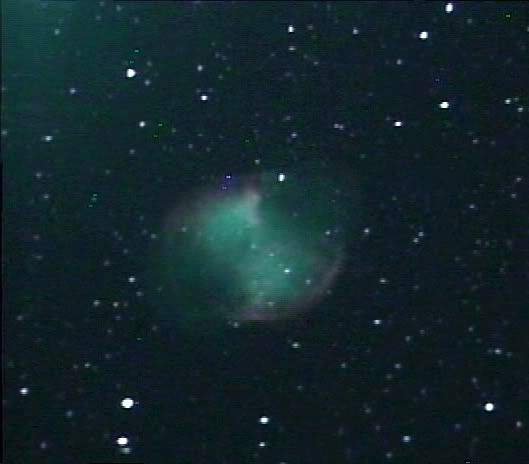
regards
Andy
#223

Posted 22 December 2011 - 01:06 AM
You got the bug! Nice work!
Try stacking more if you can, to see what you can do with more photons - M27 is very doable with the 8SE in alt/az and a bunch of 20 sec exposures. Have fun - I know you are...
Doug
#224

Posted 22 December 2011 - 01:24 AM
thanks
Andy
#225

Posted 22 December 2011 - 09:28 AM
M57

m2
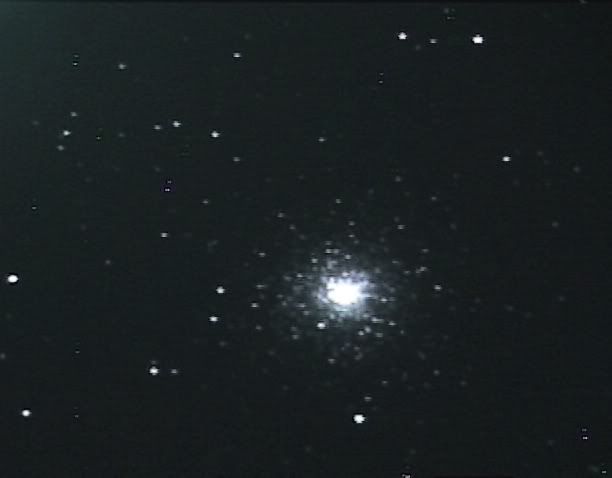
m15
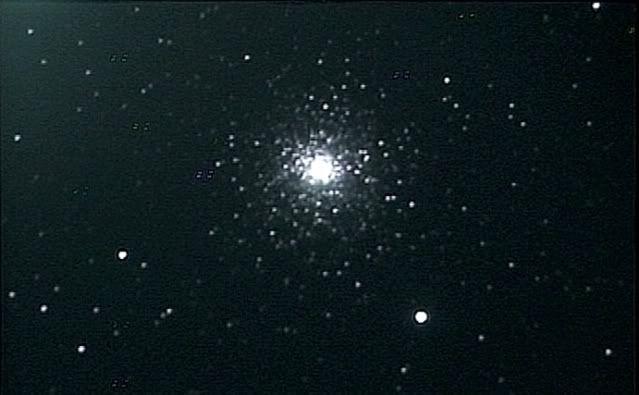
regards
Andy






